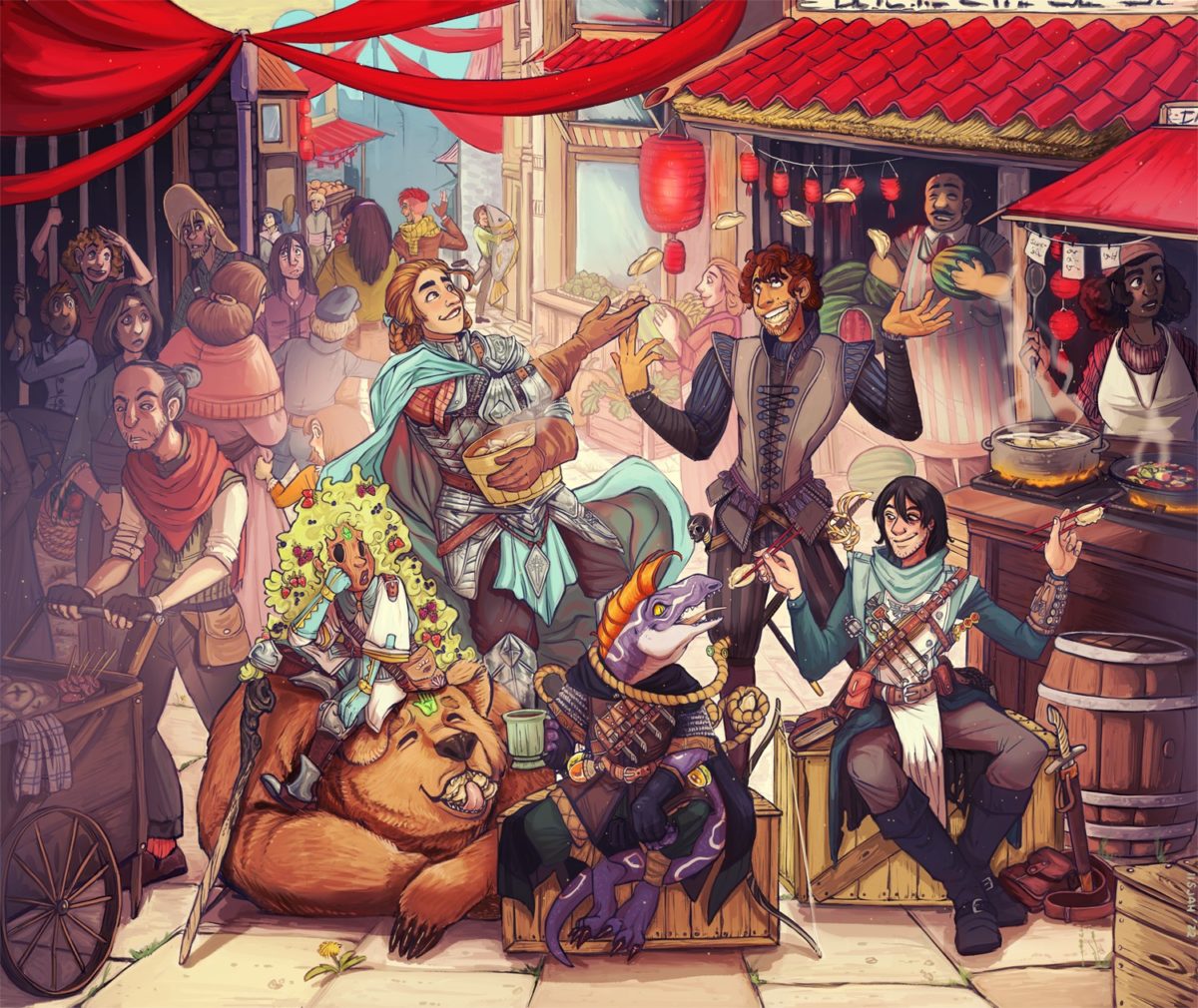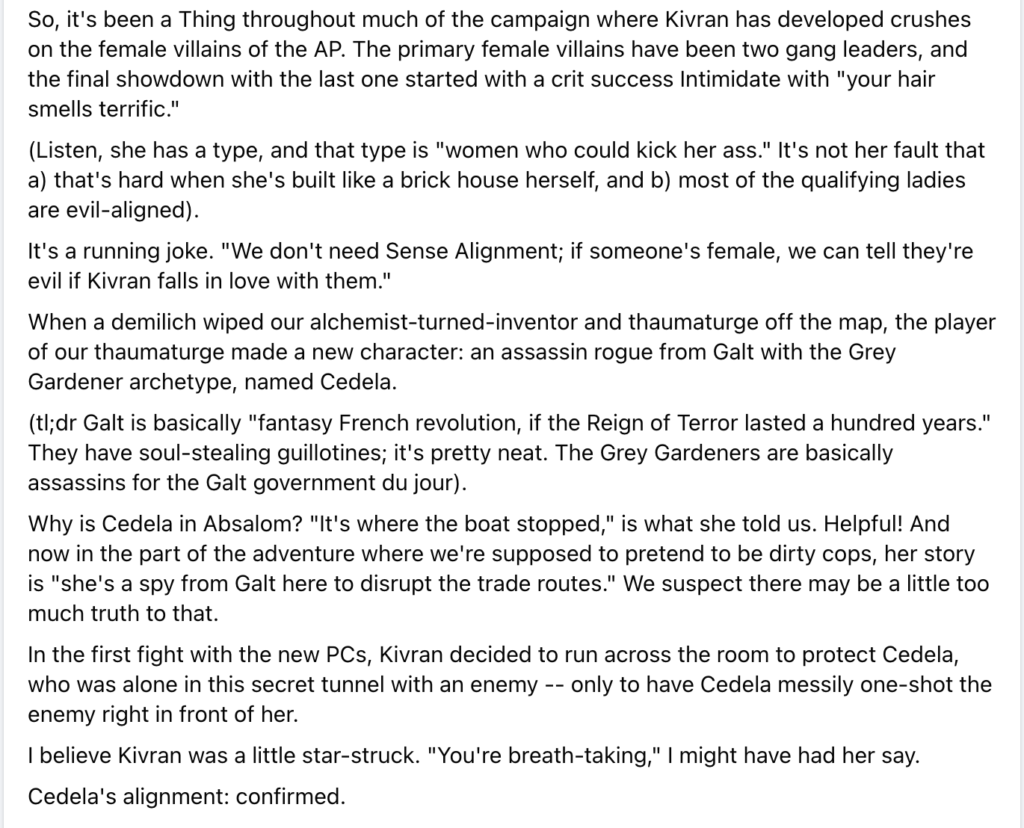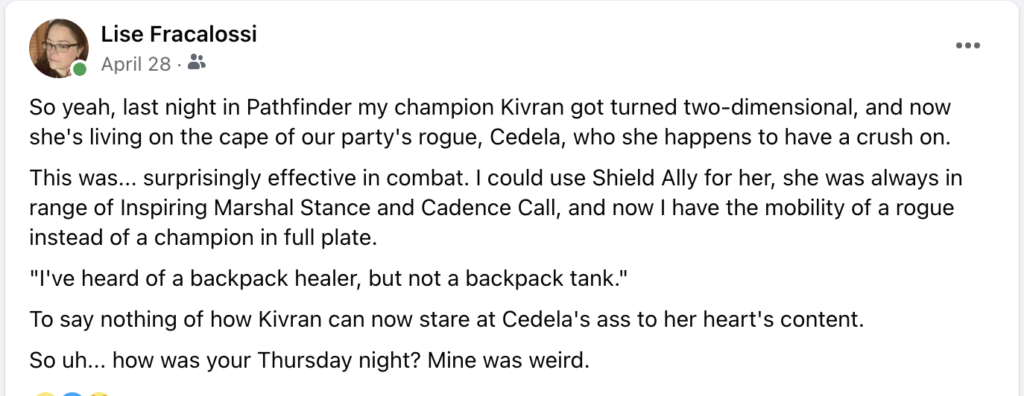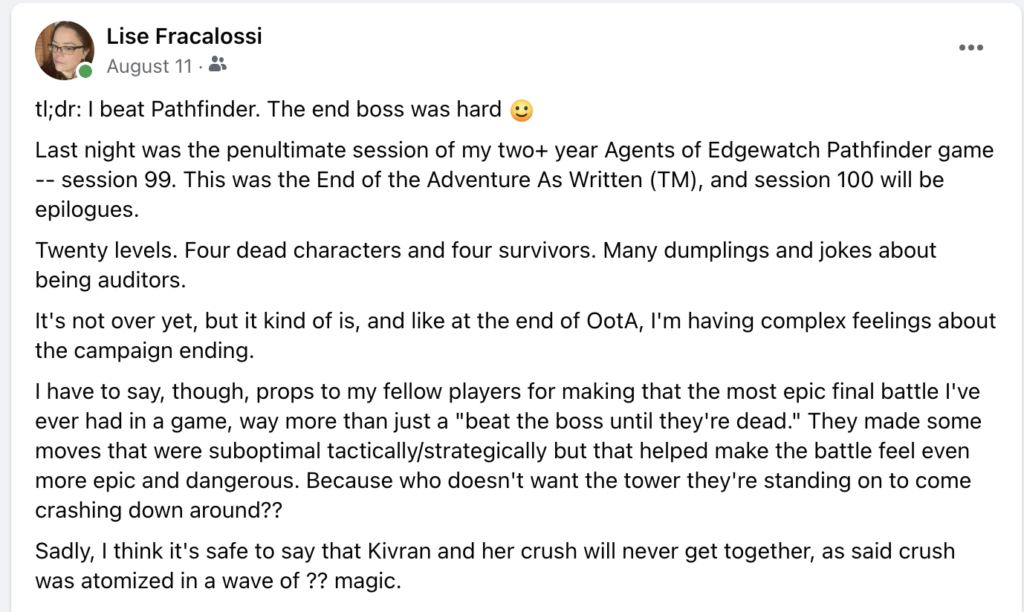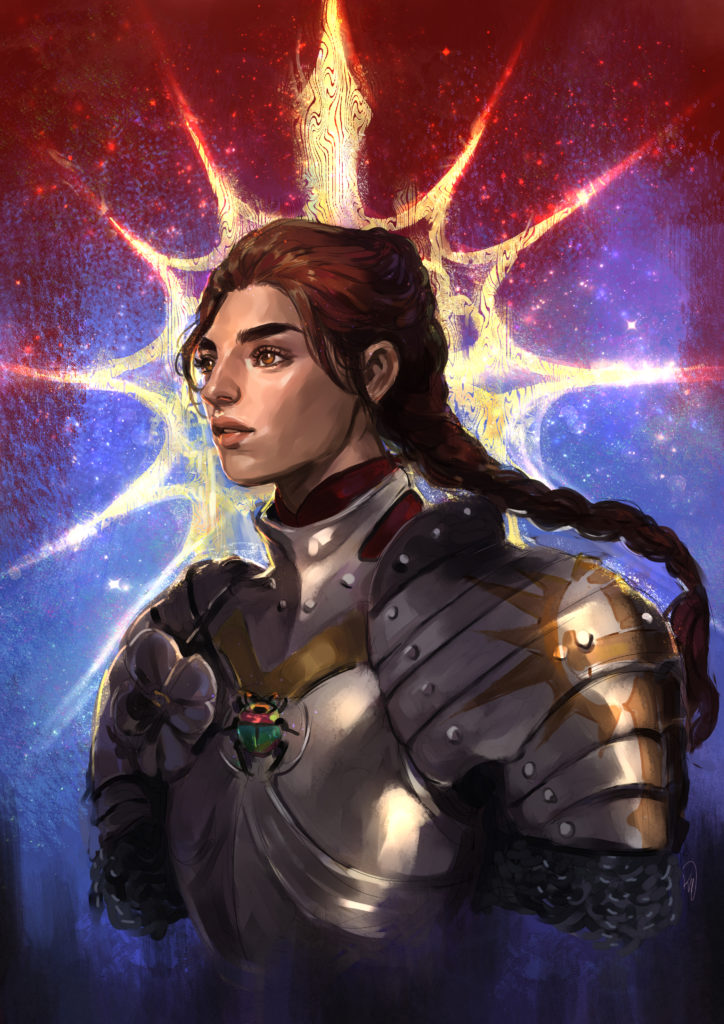A little over two years ago, I embarked on my journey into Pathfinder 2e — and a little less than two years ago, I wrote “Five months of Pathfinding,” detailing my experience with the system thus far.
Well, here it is, September 2023, and we recently wrapped up the Agents of Edgewatch campaign, the campaign we started back in May 2021. I retired my redeemer champion Kivran, and I’m about to embark on a new campaign with a thaumaturge named Tak. So at this point I’ve played a character from 1-20, played through an entire adventure/story arc, and built a new character of a different class.
I think it’s time for my much-more-informed opinions!
… in a multi-part format, as it turns out that I have MANY opinions. A whole-ass wavelength of them, in fact.
Some basics
As a starting point, let me share/remind you of the statistics on the party, campaign, variant rules, deaths, etc.
We were playing the level 1-20 Adventure Path (AP) “Agents of Edgewatch,” which can be glossed as “fantasy guards at a fantasy world’s fair.” It starts pretty lighthearted, but quickly descends into some dark and heavy stuff.
Our party was five people, and we had one GM (Josh). We had eight different characters over the course of the adventure, due to three character deaths.
For reference, player/character names and party composition:
- I was playing a Taldan human champion of Iomedae named Kivran.
- My husband Matt was playing Lucio, a Taldan human swashbuckler. Who, despite all our jokes about his absurd movement speed, was not a sylph.
- Chloe played the leshy Shep. Originally a druid, she retrained as a summoner when the class was released in Secrets of Magic. (This will be a recurring theme).
- Diego started by playing the kobold alchemist Jabi, but retrained as inventor when Guns and Gears came out. Jabi died at level 13, and he returned as Zokaratz, a fetchling witch from Shadow Absalom.
- Poor Nick went through three different characters. He started as Nathraak, a Varisian human wizard. Then, when Secrets of Magic came out, he also retrained, as a magus. Nathraak bought the farm at level 10, so he created Frøya, an Ulfen human thaumaturge. Sadly, Frøya only lasted for three levels; she died in the same battle as Jabi. Nick rerolled as Cedela, a Galtan human rogue, who was with us until the end, but died a dramatic scripted death in the final battle.
As far as variant rules go, we used Free Archetype from the get-go. Later on in the adventure, we switched from the standard progression rules to Automatic Bonus Progression (for story-related reasons which I’ll get to in a later post).
“How did you like Pathfinder, Lise?”
That would depend on when you asked me! I ended on a generally positive note — as judged by my joining the new campaign! But there were many ups and downs along the way.
You can see my “new TTRPG energy” and optimism in my August 2021 post. “Okay, this is different, and crunchier than I expected,” I seem to be saying, “but there are so many possibilities! I can work with this.” I was excited to try something new, and optimistic about what lay ahead for me and my character.
“Holy shit, this is Mathfinder!”
Sometime after that I hit a low. Maybe it was trying to figure out how shields work (“okay, so I subtract the shield’s hardness from the damage taken, then the shield and I both take the remaining damage. If the shield takes more than like 15 damage, it breaks, and has to be repaired. Plus I have to take an action each turn to raise a shield. So how useful are they, really??”) Or maybe it was the language of the Glimpse of Redemption champion reaction. (“What the hell does ‘The ally gains resistance to all damage against the triggering damage equal to 2 + your level’ mean?”)
At one point in time, I made a joke like, “Nobody said there would be math.” To which player Nick said something like, “Uh, everybody said that, Lise. There’s a reason they call it Mathfinder.”
But by that point I was learning more about the world of Golarion and Kivran’s place in it. I loved my character’s complex relationship with the church of Iomedae, and her growing connection to Pharasma. I loved coming up with fun downtime activities for our characters, like “we’re going to go over to the Foreign Quarter and get some dumplings from Tian Town.” Or “oh hey, if you’re going to the Temple of Norgorber could you pick up some Mwangi coffee?”

So I guess my opinion at that point would be “I don’t need all these rules pls let me just play D&D 5E but in Golarion.”
“How do I stealth past the bunyip?”
After a while, I could calculate myself how much damage my shield mitigated, or how much resistance my champion’s reaction granted to an ally. At the very least I was comfortable doing “champion stuff.”
But the minute I left the world of champions, I got confused.
How does stealth/concealment work? I still don’t quite know. I know there are many different degrees of “seen”, eg., undetected, obscured, hidden, invisible, etc. I know there are flat d20 rolls you have to do to hit somebody at different levels, eg. a DC5 flat check to hit someone who’s obscured.
But since I basically couldn’t stealth anyway — due to a mere 25ft of movement speed plus being CLANKY CLANK in heavy armor — it rarely came up.
… until I was forced to sneak into a dockside warehouse, and suddenly was attacked by a fish.
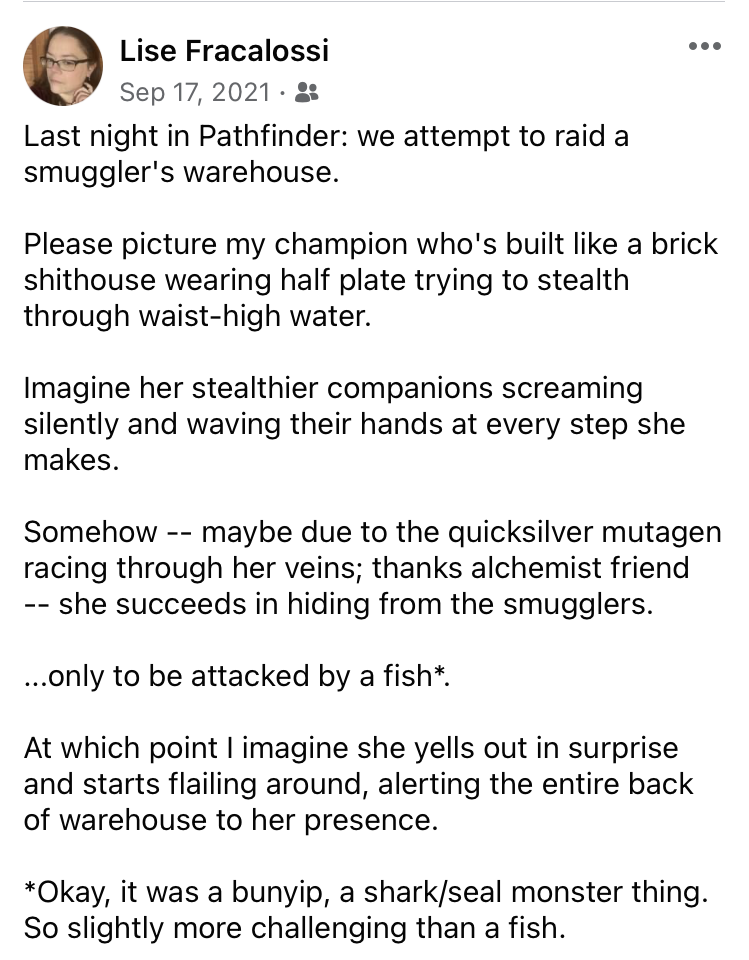
Magic was another one that was more complicated than I expected. Prepared casters vs. spontaneous casters, PF2e’s more traditional take on Vancian magic than 5e’s, four different spell lists, devotion spells, focus spells, cantrips, heightened spells, discrete vs. continuous heightening patterns, and on and on.
Mostly I didn’t have to deal with it as a champion — except for the Lay on Hands focus spell. But my fellow party members translated it simply for me — it always healed 6 * (1/2 your level rounded up).
But then I (very briefly) retrained into cleric archetype. Suddenly I had a few divine spells, and I had to figure out spell heightening. “Cleric” was appropriate as a descriptor at this point, because it felt like I was trying to read Old Church Slavonic. This conversation cleared some things up, but I promptly forgot most of it when Book of the Dead came out and I decided the Soul Warden archetype was more along the lines of what I wanted for Kivran, and so — yup — I retrained.
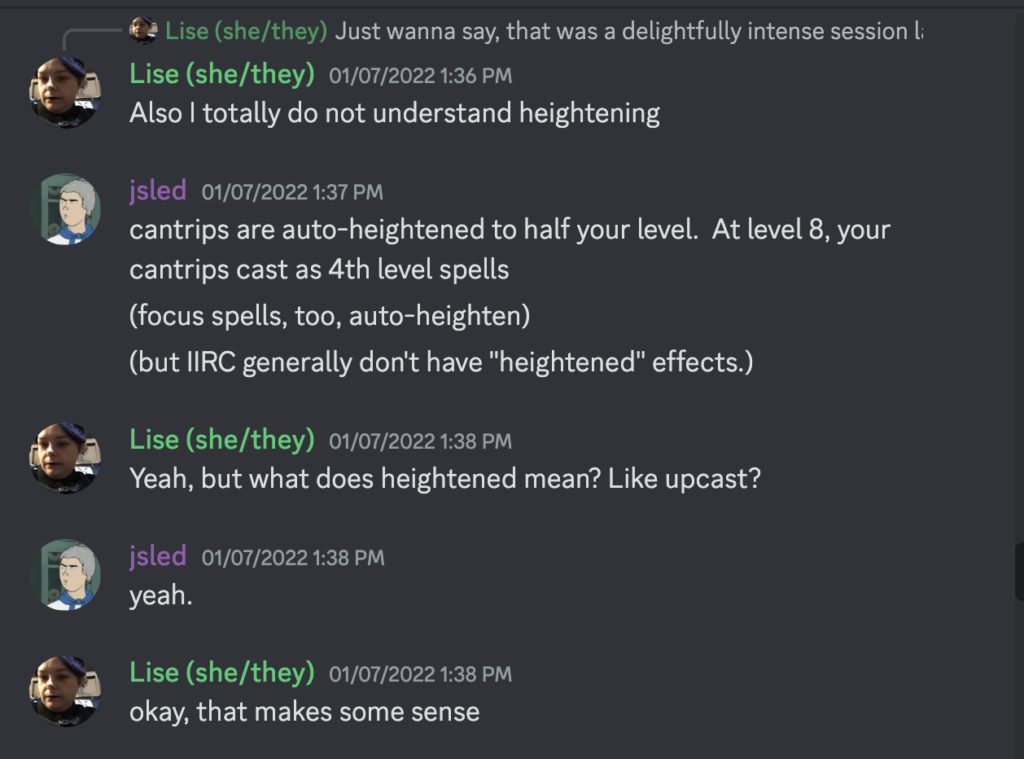
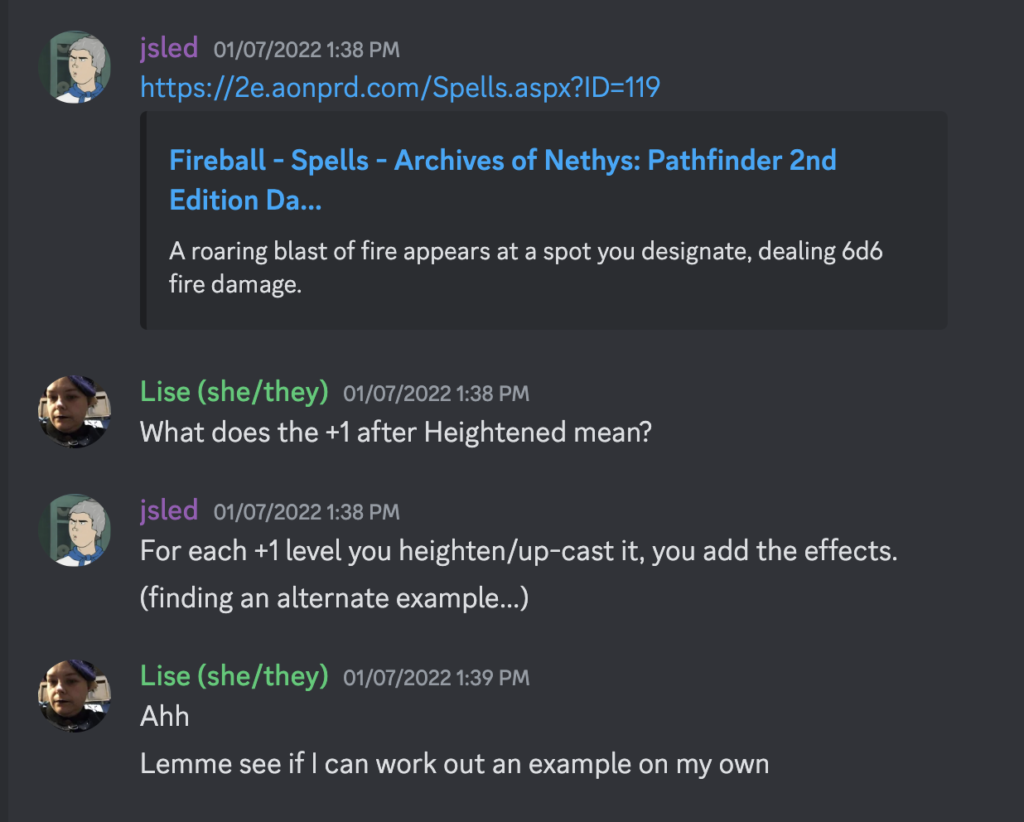
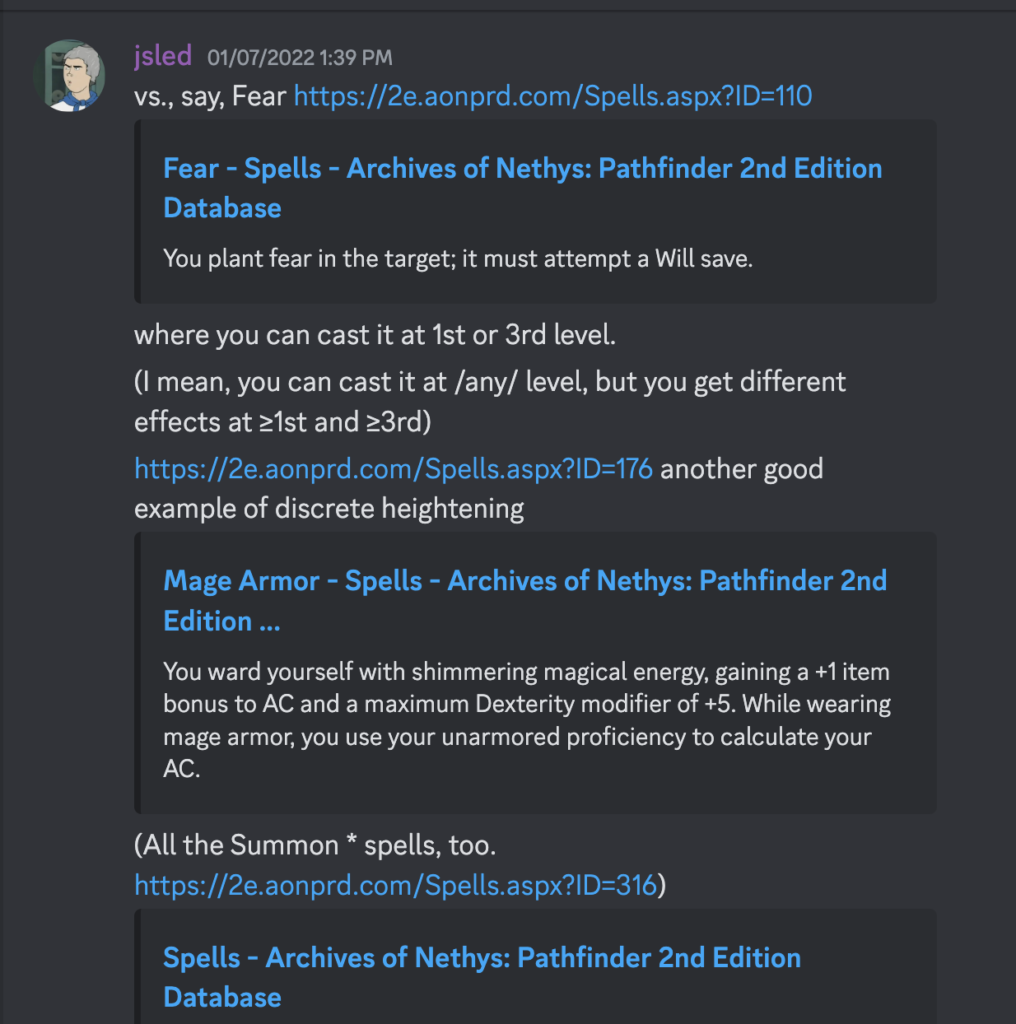
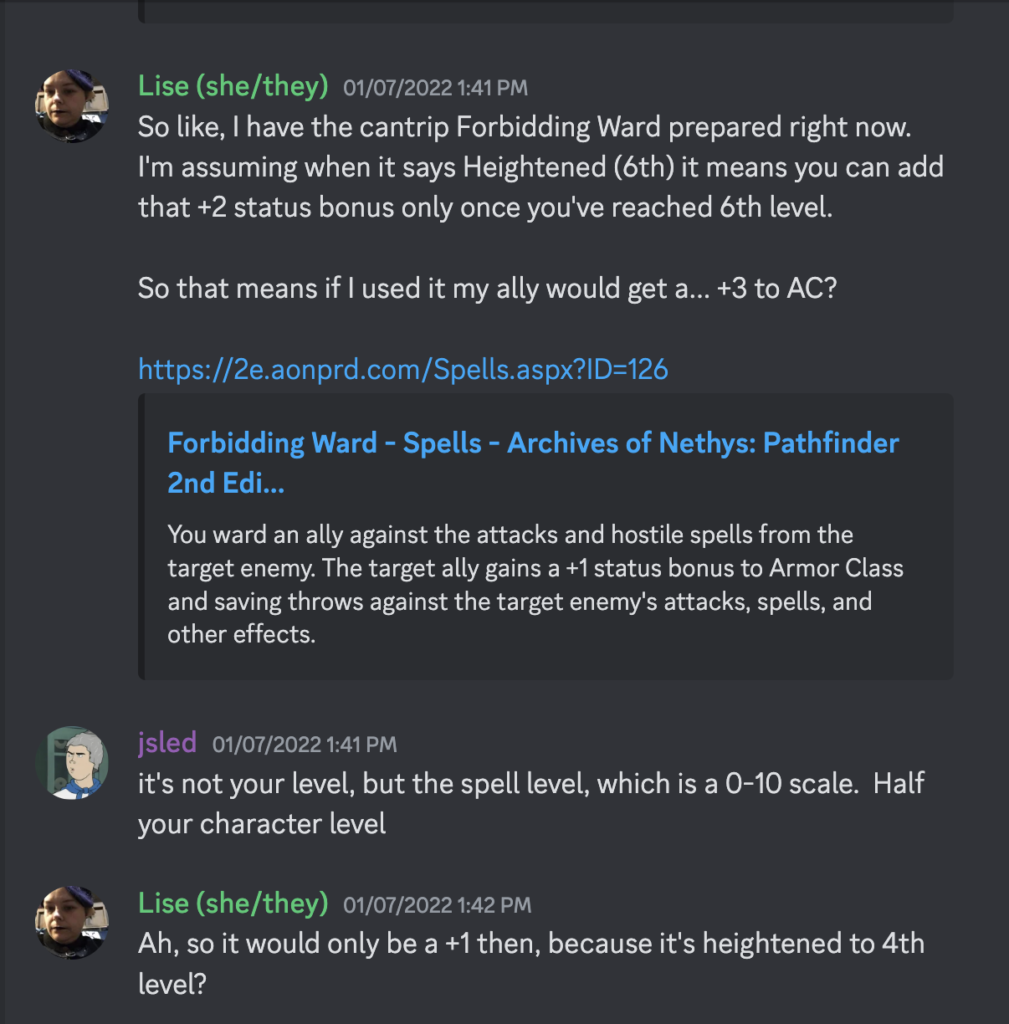
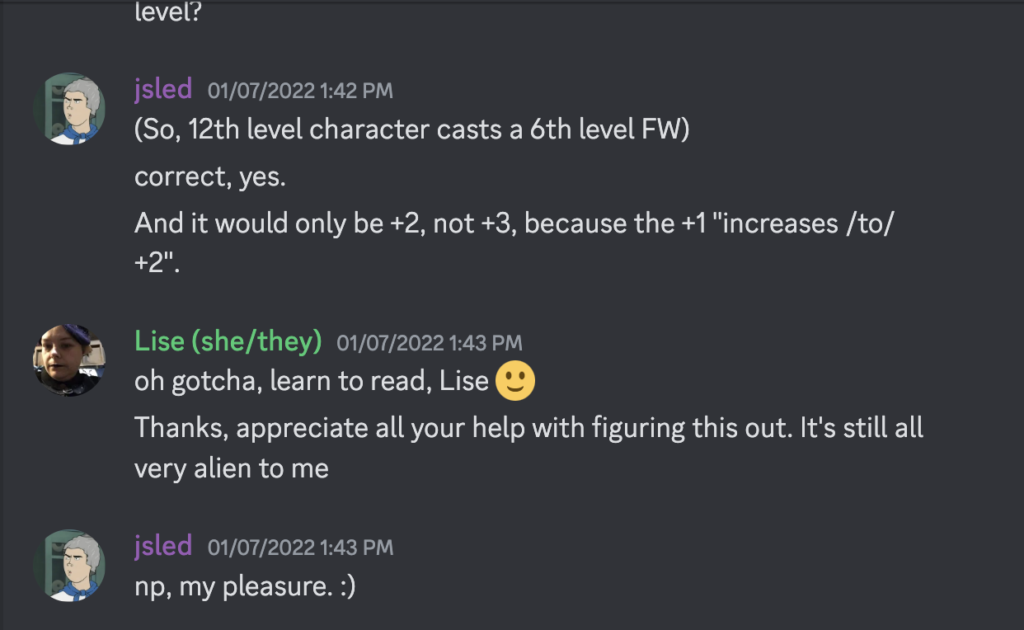
Other points of confusion: the stages of poisons and diseases. Grappling (has this actually changed from the bullshit that was 3.5?) Counteract checks.
“Why am I not playing a rogue, again?”
I think another downturn for me was when we hit level 13, and we lost Jabi and Frøya in the same battle. That wasn’t the issue itself — the issue was a combination of factors that made me feel a lot weaker than the other party members.
One was that the new characters came in at level 15, while the survivors needed to wait until the end of the chapter to be leveled up two levels. (I presume the GM was like, “uh, the party just lost two characters; they need a little bit more fire power and HP to actually survive this encounter”).
At around this level, too, the damage numbers for dps classes just got absurdly high. My husband’s swashbuckler gets in an appropriate finisher and rolls well? 100+ damage. (To say nothing of his absurd move speed; Mr. “I have 75ft of movement speed plus I also have a fucking climb speed when I have Panache”). Our new rogue Cedela gets trapped in a narrow hallway with a bad guy? I shuffle over at “I’m wearing plate armor” speeds to protect her, only to watch the bad guy be wiped off the map in one of the rogue’s turns.
What also felt bad was the fact that the rogue also went in the Intimidation direction, an area I had invested in heavily for Kivran. It often felt like we were competing to see who could Demoralize an opponent first — and Cedela had the higher Perception, so it was mostly gonna be her.
I was also annoyed when I found out that she had the Scare to Death feat, the pinnacle of the Intimidation skill feat line. “How do you have that at level 15? I can’t get it until level 16,” I asked Nick one day.
“Oh, rogues get skill feats every level instead of every other level,” he answered.
It was completely irrational, but it felt like the rug (or rogue heyyyy) being pulled out from under me. I thought I understood the system, and I expected that once I understood it, I’d have the class fantasy. But it turns out the system had more surprises for me, and I didn’t have what I wanted, after all.
While the class fantasy of a redeemer champion isn’t, and shouldn’t be, doing damage, it does suck when you feel like you don’t have a chance to even get to the fight before combat ends. Everything a redeemer does well involves being within 15′ of the enemy and allies, after all. And it always sucks feeling like someone else in the party is taking over “your thing” — Intimidation/Demoralize, in this case.
“I finally feel like the tanky tank I wanted to be.”
The level wonkiness worked itself out once we were all level 15. And the rogue’s player and I got better about not stepping on each other’s toes with Intimidation — even learning the advantages of having two people who can Demoralize.
But the “class fantasy” part I had to make a conscious effort to fix. I did that by retraining — basically reallocating some of my character choices.
I can’t take all the credit, though. My party members were amazing. Hearing that I wasn’t having fun, they all threw out a bunch of suggestions for retraining, some wackier than others.
Ultimately I dropped the Edgewatch Detective archetype in favor of the Marshall archetype, focusing on Inspiring Marshall Stance (the Diplomacy option) rather than Dread Marshall Stance (the Intimidation one — I again wanted to avoid overlapping the rogue). Job done: I immediately felt like a hero. I get to pose dramatically, and it empowers all my allies. Then I can also do things like give them an extra action!
Later on I also added on the Bastion archetype, which improved my shield and shield block action, allowing me to do things like block attacks to adjacent allies.
Finally, I was the tanky tank of my dreams, and things were good.
“How can I keep track all these feats?”
Look, this game is crunchy. And like anything complex, the complexity increases exponentially, not linearly, as the system grows.
In PF2e, some of the most important puzzle pieces are feats. Each feat is a cool thing your character can do that breaks the rules in a small way and differentiates them from others. They’re comparable to feats in D&D 5e, in that way, but unlike in 5e, where they’re rare (and have to be swapped out for an ability score increase), you get a feat or multiple feats at every level in addition to your ASIs.
In fact, by the time you reach level 20 in this game, you will have +/- 32 feats of different types. With the popular Free Archetype variant rule, you’ll add on an additional 10 class and/or archetype feats.
This is vastly simplified, due to variant rules, differing class progressions, types of feats being tradable in various ways, etc — but you get the idea. You have a lot of what are essentially variant rules and special actions to keep track of.
By the time I reached level 17, I had around 40 feats, and man was the cognitive load high, especially during combat. I’d (mostly) plan what I was going to do on my turn, but when my turn came up and I said it aloud, somebody would say, “oh remember you have [other feat],” or “remember [this buff given by one of their feats],” and “probably not a good idea to use [that action] now because X.” It kind of turned into combat by committee.
There also ended up being a lot of retconning — “oh wait, I didn’t actually have my shield raised, so I couldn’t have blocked that. I should actually take full damage and my shield should take none.”
None of this felt good.
Surprisingly, combat didn’t bog down nearly as much as I expected under this weight. I’m not sure if this is due to a general systems improvement over 1e/D&D 3.5e (the latter being where I once battled a purple worm for six hours of real time), or that my fellow players were systems experts who planned out their turns ahead of time and helped others do the same. Or both!
But still… I often joked I needed a flowchart to play my character.
“… that’s the neat thing, you don’t.”
Around that time was the OGL 1.1 kerfuffle I wrote about here. This definitely made me much more invested in Pathfinder as an ecosystem, seeing how Paizo responded (sometimes with delightful cattiness) to Wizards’ poor business and ethical decisions.
It also led to me watching a lot more YouTube videos about Pathfinder, which is where I discovered The Rules Lawyer, who (imho) is the savviest and most entertaining of the YTers in this space.
In his video Let’s do the SAME COMBAT in D&D and Pathfinder 2E!, he dropped a piece of wisdom on me that has stuck with me. It has helped me feel better about making mistakes, retconning things, house ruling things on the fly, etc.
The quote (beginning at 13:30; emphasis mine):
So as you can see a number of modifiers can happen in a single roll, which can be overwhelming at first. Though in my experience it’s something people get used to. And if you’re not tracking it all and nobody’s noticing you’re still having fun.
Was I having fun? I sure was. In character, Kivran was developing a crush on Cedela, thus perpetuating the “Kivran has a type, and that type is evil women who look like they could suplex her” joke.
Out of character, I still genuinely liked the other players, who were helpful, funny, and like-minded. How did I find these amazing people on r/lfg, and how were we still getting along two years later?? It truly is a miracle.
Around this time I was also realized that this isn’t just difficult for me. Nick, perusing his character sheet at the start of his turn, once said, “Okay, let me see if I can find some bullshit that can help in this ridiculously long list of feats.” (“Oh yeah,” I remembered, “Cedela has twice as many skill feats as Kivran”). Diego, who played our witch, also had a very complicated build, and often mentioned how much anxiety he had before every turn.
Given the high level of systems knowledge these two players had — enough so that their idea of a fun time is “rebuilding PF1e classes in PF2e” and “homebrewing a variant system for crafting magic items” — I knew no one expected me to know it all and to get it right 100% of the time.
Challenge accepted
As we reached level 18 or so, I realized another thing that was different from 5e: It was still challenging.
At level 18 or 19, there was at least one battle where we were forced to retreat from a combat to avoid character death(s). In the same dungeon, we also came across a trap that, if run RAW, would have one-shot Kivran and outright killed her via the Death trait. (GM Josh ran it as “this seems incredibly overtuned to me; let’s just play it out and see what happens; no consequences”).
My general feel about challenge is: if death, and loss of your character, isn’t on the table, it’s not fun. Nothing means anything if it can’t be taken away, and, as I’ve said before, there’s no emotion that humans won’t pay to experience in the safe environment of a story. That includes loss, grief, and fear.
So to see us still struggling in a meaningful way — at the level where, in Out of the Abyss, our party was able to defeat multiple demon lords in a single battle, almost untouched — was really fucking cool.
Also, not only were the encounters challenging, they were interesting. One of my favorite fights in those high levels was when we were attacked by a living mural, which turned some of us temporarily two-dimensional. This led to Kivran being worn on the cloak of her beloved Cedela for the rest of the session — a situation which had surprisingly few downsides!
Or, as the GM said, when I asked if I could still take the Demoralize action as a 2D picture on a cloak: “Sure, because Cedela’s ass does not quit.”
The end of the road
Finally we reached level 20. I will admit, at that point, the challenge did sort of vanish. I permanently had a raised shield, I could use Glimpse of Redemption and Shield Warden on the same ally at the same time, and I could make monsters shit their pants with fear just by walking into a room. We crushed our way through the final dungeon in record time, and it seemed like nothing could stand up to us for more than a couple of combat rounds.
Given that, the final battle might have been astonishingly anti-climactic… except that the other players did everything they could to make it awesome.
Zokaratz threw out some, um, ill-advised spells that caused the room to start falling apart around us, video game boss battle-style. At one point Lucio was climbing up the wall with Zokaratz on his back to escape the collapsing floor, and Shep’s bear eidolon was scrambling to avoid falling into the ever-growing pit at the center of the room. As part of a scripted death, Cedela exploded in a fine mist of blood upon striking down the Big Bad, splattering Kivran (who was fighting beside her). It ended with us all piling into a portal to Shadow Absalom to escape the falling tower, in a “come with me if you want to live” moment.
It was easily the most epic final battle I have ever seen in a tabletop campaign. (Yes, even moreso than Out of the Abyss).
In Conclusion (for now)
That final battle was definitely a high point to end on, and that informs the positive tone of this post. But it is interesting to think that if I had stopped playing at certain points, my opinions might never have evolved to this level, and I might be telling everybody about what a bad experience I had and how I’d never play Pathfinder again.
I also think that if my group hadn’t been so ding-dang awesome, it wouldn’t have been as enjoyable. I can easily picture playing with a less experienced group, where we were all confused by the mechanics. That picture includes hours of time wasted looking up and arguing over rules, and it just isn’t pretty.
I can also picture a boring final battle, if we had all played optimally and just beat the boss until they were dead. And without the RP and character development I put into Kivran (and which the others nurtured), I wouldn’t have been as invested in the outcome.
Lucky for you, it’s been a positive experience, and I still have lots more to say about it. Next time I’ll get more detailed on how crunchy the game mechanics are, and help you to answer the question of “would I enjoy this game?”
Featured image: Party art by Iisjah Art/Natalia Komuniewska. An early iteration, since we still have Jabi and Nath!
